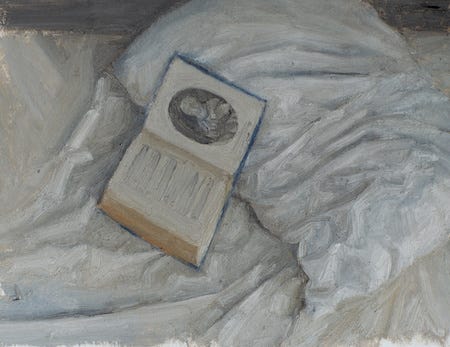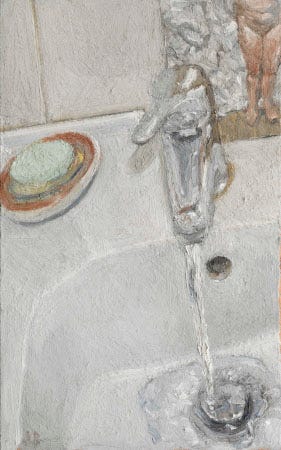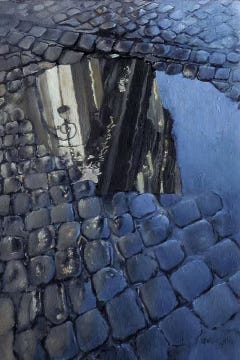The turbulent bedscapes of Justin Bradshaw - London born painter based in Italy
Rooms where we are not
For Justin Bradshaw, a dreamer of ruins and ancient churches, the grandeur and decline of Rome are always in his thoughts: How the city speaks to us from so many centuries all at once. How we stumble into a palimpsest of time, turning a corner in the old ghetto.
A conjurer of everyday illusions, he delights in mirror effects. Car windows capture fragments of monumental Rome. A lighted window glances off a puddle on the cobblestones, hinting at the existence of an underworld.
In his still-life paintings, Bradshaw re-enchants the ordinary, celebrating those meek, unassuming objects that populate our homes—not lifeless things, but playful presences in themselves, worthy of our attention. Humble yet luscious heads of cabbage or cauliflower, sexy flower buds, lace-up boots scattered with crumbs of mud, pencils with a slightly gnawed air floating alone in space. He has a predilection for the imperfect, the flawed, the timeworn, the used-up—a breakfast croissant burnt to a crisp, a goblet knocked over, and dozens of squeezed-out, twisted, tormented paint tubes, which seem like ironic icons of the artist’s own self.




Rooms in which we are not. Signs of fleeting habitation.
Picture a room when you are not there: How it lives and breathes in a light of its own. Bradshaw’s interiors capture the eerie stillness that lingers when the human occupants have fled the scene. A sheet thrown across an armchair bears the slight impress of an absent body. An old book tossed aside on a rumpled pillow evokes an insomniac’s bedtime reading. Battered boots kicked off beside an empty, unmade bed make us wonder where the sleeper has wandered off to. Water trickling from a faucet in a bathroom sink suggests the presence of someone standing just out of sight—the postcard or perhaps a small mirror propped up on the edge of the sink offers a furtive, partial glimpse of a female nude.


Then there are the beds—dubbed “bedscapes” by one collector—an apt term for these mysterious, nocturnal scenes. Unmade beds have obsessed the artist for over a decade now, since his series L’Anima Ferita—the “Wounded Soul,” inspired by Monteverdi’s opera L’Arianna. (of which all has been lost save the aria The Lament of Arianna) The beds in the Arianna series are luxurious and inviting; the billowing white sheets are baroque and pristine; bridal sheets not shrouds. The beds are sometimes empty, other times occupied by an intense, glamorous dark-haired woman. Arianna, sleepless in her sorrow, waits out the night after being abandoned by Theseus on Naxos. Despite the pain and rage of her wounded soul, the story will have a happy ending, for the god Dionysus will fall in love with her, marry her, and transform her into a constellation when she dies.
The new beds, recently exhibited in Paris at the Galerie Sardine and in Los Angeles at Studio Dosa, offer a twist on his bedscapes. These austere, narrow beds call to mind the privations of institutional dormitories. Rendered in somber earth tones on a black background with covers in disarray, pillows teetering on the wrong end—these beds convey the restless atmosphere of feverish insomnia, somnambulism, tempestuous love-making, abandonment, nightmares, struggles with an incubus.
Within this series, Bradshaw’s technique evolves from minutely detailed, painstaking hyperrealism towards a more abstract vision, emerging through rougher textures, with paint thickly applied in forceful, impatient jabs. Unlike his earlier still lifes, which draw you closer to appreciate their finely rendered details, here you must step back and let the energies of the paintings recompose themselves before your eyes. Gray sheets ripple vigorously in zig-zag patterns—the black backgrounds subtly alive with faintly luminous streaks and swirls, which might be the creeping light of dawn or the outer manifestations of an oneiric experience.
In this series, one empty bed follows another until finally, a human figure appears, like a fragment floating up from a distant memory or dream. The person—brown, of indeterminate sex—lies on their side, knees drawn up in the fetal position, abandoned in sleep or curled up in the throes of physical or mental distress. We are left puzzling—who lies in that bed? What world will they wake to?
Enigmatic, tinged with irony, often elegiac and sometimes unsettling—Justin Bradshaw’s paintings imagine not just where we have been, but the weight of our absence when we’re gone.
More about my writing may be found here:
For more on Justin Bradshaw’s work, see this early substack
A visit to the studio of Justin Bradshaw
We’d heard the road was daunting in rainy weather, so we waited for a dry day before visiting artist Justin Bradshaw in his studio near Corchiano. Ignoring the “Divieto di Transito” sign, we followed the artist in our little Aygo as far as it would go – but when it tilted dizzily up on one side as we rumbled along a deep ru…












This is wonderful! I’m a collector of Justin’s work, and a friend, and it was a pure delight to read this.
Beautiful prose, Linda! It's a rare treat to see the themes that have inspired me described with a clarity and attentiveness that only a talented writer and observer could express.